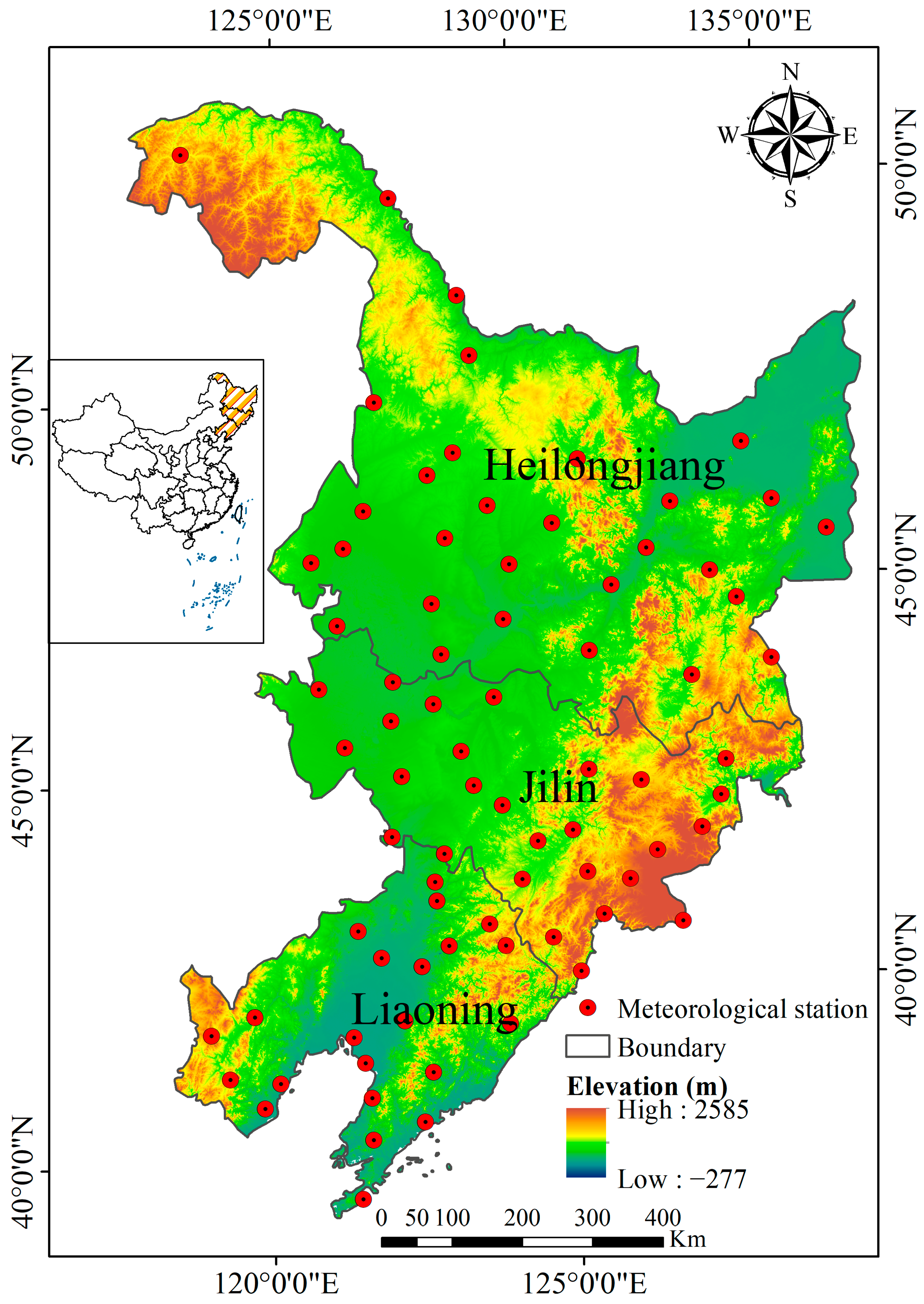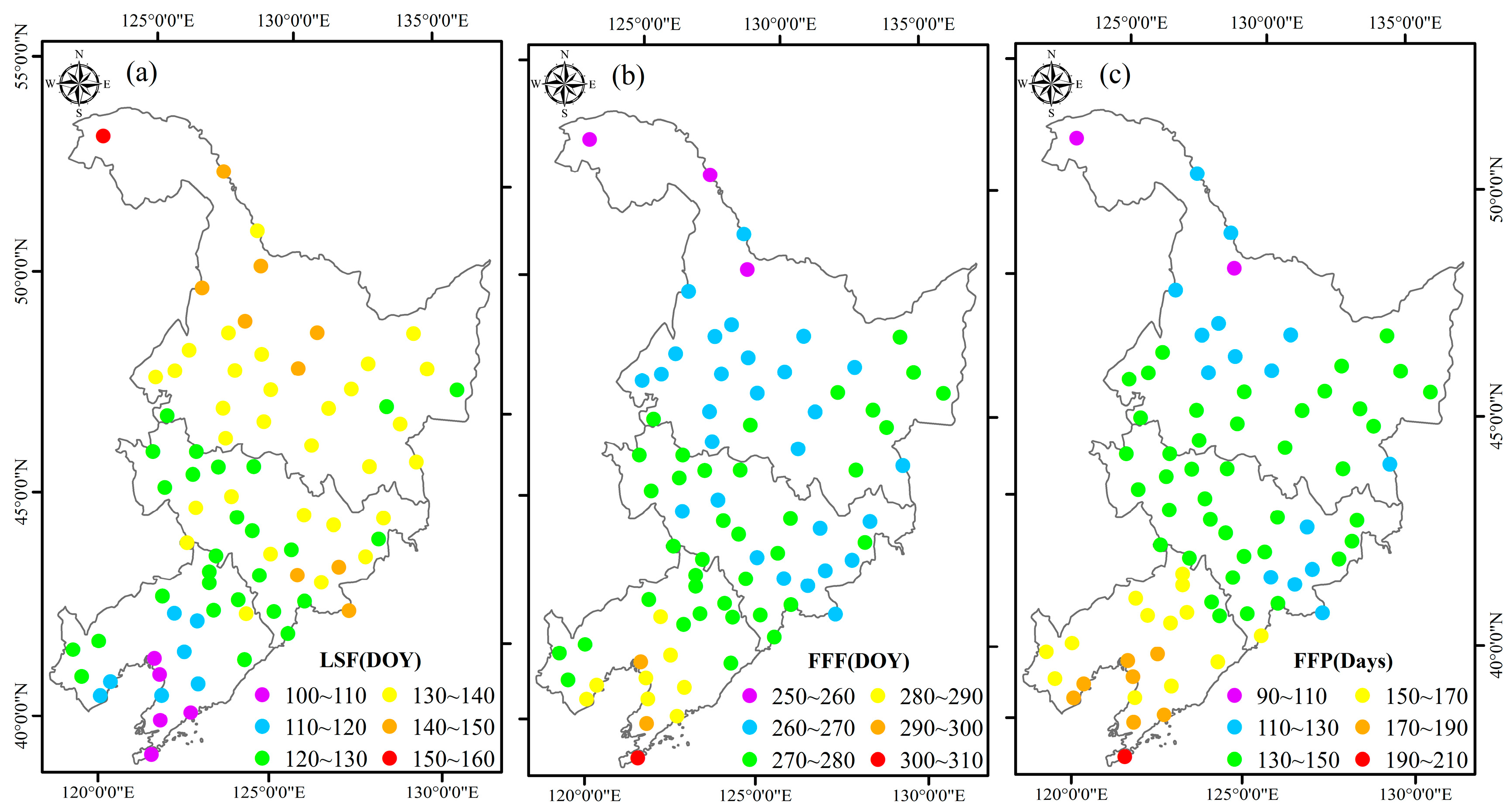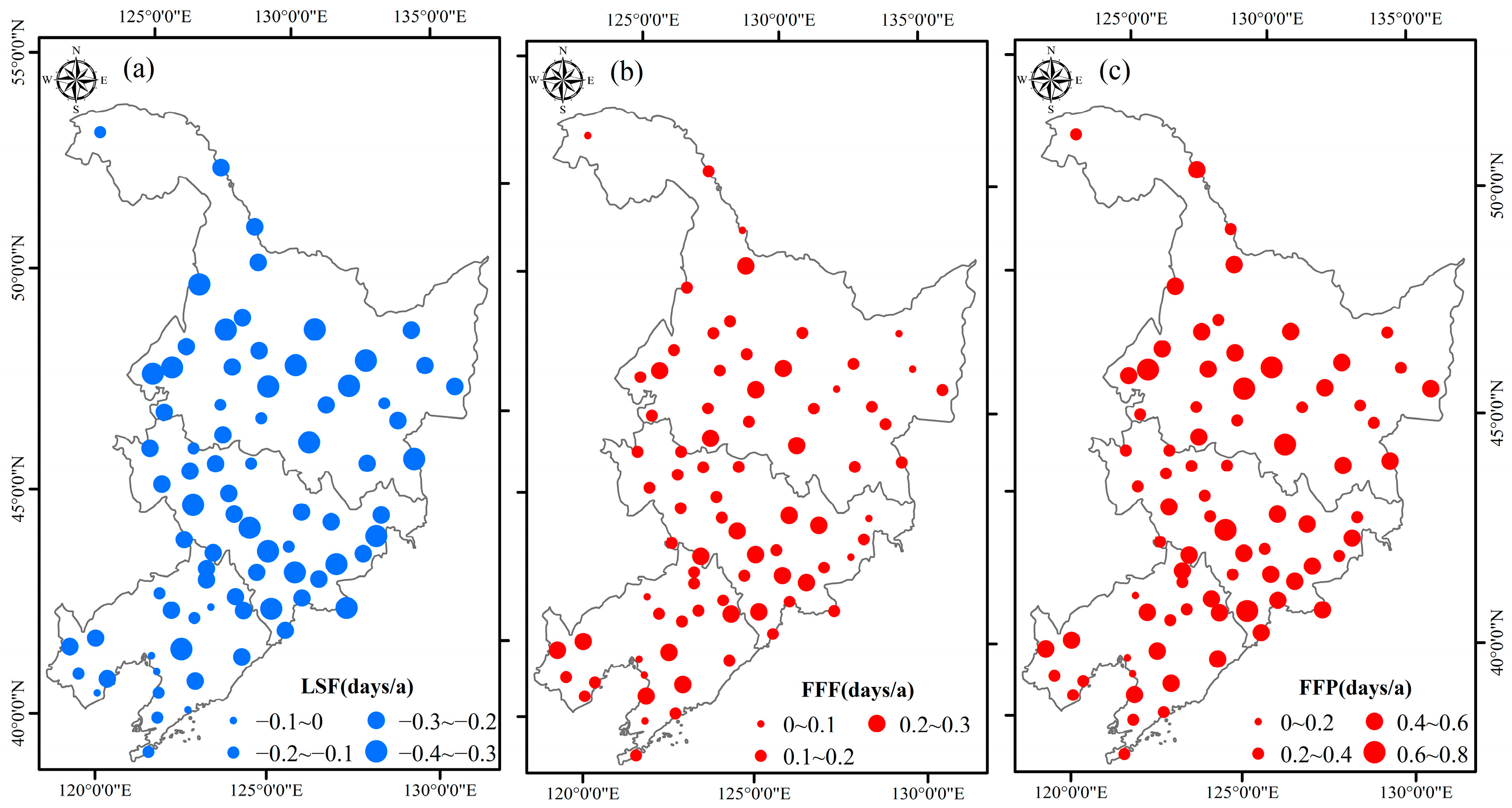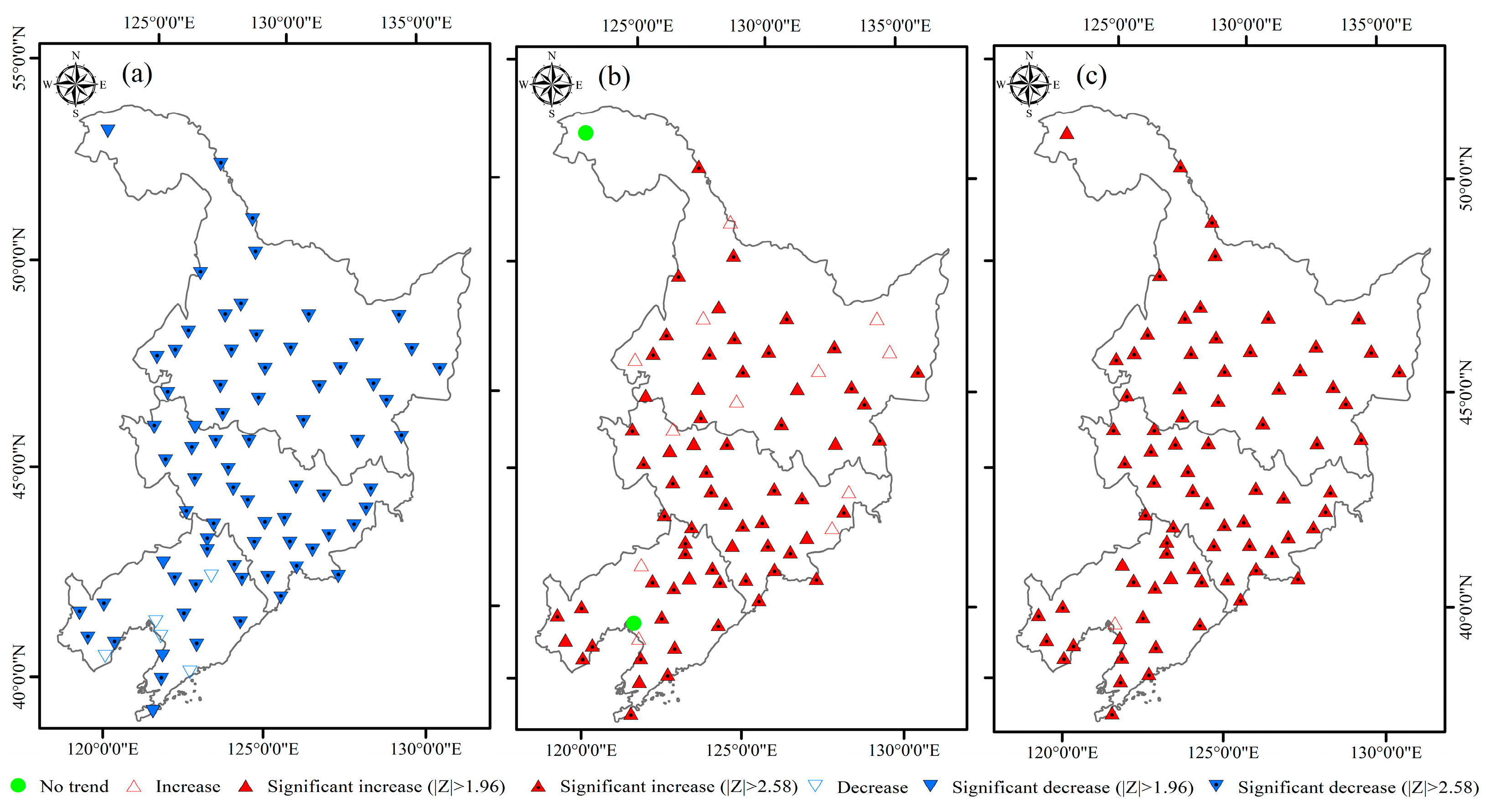Temporal and Spatial Variability of Ground Frost Indices in Northeast China
Abstract
:1. Introduction
2. Materials and Methods
2.1. Study Area
2.2. Data
2.3. Methods
2.3.1. Definition of Frost Indices
2.3.2. Trends Analysis
2.3.3. Mutation Analysis
2.3.4. Correlation Analysis
3. Results
3.1. Spatial Distribution of the Frost Indices
3.2. Interannual Trend of the Frost Indices
3.3. Spatial Distribution of the Variation Trend in Frost Indices
3.4. Mutation Analysis of the Frost Indices
3.5. The Relationship between the Frost Indices and Geographic Factors
4. Discussion
4.1. Annual Average and Spatial Distribution of the Frost Indices
4.2. The Dynamic Changes of the Frost Indices
4.3. The Impact of Climate Change on the Frost Indices
4.4. Limitations
5. Conclusions
Author Contributions
Funding
Institutional Review Board Statement
Informed Consent Statement
Data Availability Statement
Acknowledgments
Conflicts of Interest
References
- IPCC. Climate Change 2021: The Physical Science Basis; IPCC: Geneva, Switzerland, 2021.
- Pérez, J.; Correa-Araneda, F.; López-Rojo, N.; Basaguren, A.; Boyero, L. Extreme temperature events alter stream ecosystem functioning. Ecol. Indic. 2021, 121, 106984. [Google Scholar] [CrossRef]
- Zhao, Q.; Guo, Y.; Ye, T.; Gasparrini, A.; Tong, S.L.; Overcenco, A.; Urban, A.; Schneider, A.; Entezari, A.; Vicedo-Cabrera, A.M.; et al. Global, regional, and national burden of mortality associated with non-optimal ambient temperatures from 2000 to 2019: A three-stage modelling study. Lancet Planet Health 2021, 5, e415–e425. [Google Scholar] [CrossRef] [PubMed]
- Shen, X.; Jiang, M.; Lu, X.; Liu, X.; Liu, B.; Zhang, J.; Wang, X.; Tong, S.; Lei, G.; Wang, S.; et al. Aboveground biomass and its spatial distribution pattern of herbaceous marsh vegetation in China. Sci. China Earth Sci. 2021, 64, 1115–1125. [Google Scholar] [CrossRef]
- Ma, R.; Xia, C.; Liu, Y.; Wang, Y.; Zhang, J.; Shen, X.; Lu, X.; Jiang, M. Spatiotemporal Change of Net Primary Productivity and Its Response to Climate Change in Temperate Grasslands of China. Front. Plant Sci. 2022, 13, 899800. [Google Scholar] [CrossRef] [PubMed]
- Shen, X.; Liu, Y.; Zhang, J.; Wang, Y.; Ma, R.; Liu, B.; Lu, X.; Jiang, M. Asymmetric Impacts of Diurnal Warming on Vegetation Carbon Sequestration of Marshes in the Qinghai Tibet Plateau. Global Biogeochem. Cycles 2022, 36, e2022GB007396. [Google Scholar] [CrossRef]
- Shen, X.; Shen, M.; Wu, C.; Penuelas, J.; Ciais, P.; Zhang, J.; Freeman, C.; Palmer, P.I.; Liu, B.; Henderson, M.; et al. Critical role of water conditions in the responses of autumn phenology of marsh wetlands to climate change on the Tibetan Plateau. Glob. Change Biol. 2023, 30, e17097. [Google Scholar] [CrossRef] [PubMed]
- Haggag, M.; Rezk, E.; El-Dakhakhni, W. Machine learning prediction of climate-induced disaster injuries. Nat. Hazards 2023, 116, 3645–3667. [Google Scholar] [CrossRef]
- Zhang, Z.; Wang, P.; Chen, Y.; Zhang, S.; Tao, F.; Liu, X. Spatial pattern and decadal change of agro-meteorological disasters in the main wheat production area of China during 1991–2009. J. Geogr. Sci. 2014, 24, 387–396. [Google Scholar] [CrossRef]
- Xu, X.; Tang, Q. Spatiotemporal variations in damages to cropland from agrometeorological disasters in mainland China during 1978–2018. Sci. Total Environ. 2021, 785, 147247. [Google Scholar] [CrossRef]
- Guan, X.; Zang, Y.; Meng, Y.; Liu, Y.; Lv, H.; Yan, D. Study on spatiotemporal distribution characteristics of flood and drought disaster impacts on agriculture in China. Int. J. Disast. Risk Re. 2021, 64, 102504. [Google Scholar] [CrossRef]
- Li, Y.; Zhao, S.; Wang, G. Spatiotemporal Variations in Meteorological Disasters and Vulnerability in China During 2001–2020. Front. Earth Sc. 2021, 9, 789523. [Google Scholar] [CrossRef]
- Xu, X.; Tang, Q. Meteorological disaster frequency at prefecture-level city scale and induced losses in mainland China during 2011–2019. Nat. Hazards 2021, 109, 827–844. [Google Scholar] [CrossRef]
- Yeşilırmak, E. Climatology and trends in temperature-based agroclimatic indices over western Anatolia, Türkiye. Theor. Appl. Climatol. 2022, 150, 1233–1252. [Google Scholar] [CrossRef]
- Tonelli, E.; Vitali, A.; Malandra, F.; Camarero, J.J.; Colangelo, M.; Nolè, A.; Ripullone, F.; Carrer, M.; Urbinati, C. Tree-ring and remote sensing analyses uncover the role played by elevation on European beech sensitivity to late spring frost. Sci. Total Environ. 2023, 857, 159239. [Google Scholar] [CrossRef] [PubMed]
- Papagiannaki, K.; Lagouvardos, K.; Kotroni, V.; Papagiannakis, G. Agricultural losses related to frost events: Use of the 850 hPa level temperature as an explanatory variable of the damage cost. Nat. Hazards Earth Syst. Sci. 2014, 14, 2375–2386. [Google Scholar] [CrossRef]
- Girardin, M.P.; Guo, X.J.; Gervais, D.; Metsaranta, J.; Campbell, E.M.; Arsenault, A.; Isaac-Renton, M.; Hogg, E.H. Cold-season freeze frequency is a pervasive driver of subcontinental forest growth. Proc. Natl. Acad. Sci. USA 2022, 119, e2117464119. [Google Scholar] [CrossRef] [PubMed]
- Meehl, G.A.; Tebaldi, C.; Nychka, D. Changes in frost days in simulations of twentyfirst century climate. Clim. Dyn. 2004, 23, 495–511. [Google Scholar] [CrossRef]
- Vitasse, Y.; Bottero, A.; Cailleret, M.; Bigler, C.; Fonti, P.; Gessler, A.; Levesque, M.; Rohner, B.; Weber, P.; Rigling, A.; et al. Contrasting resistance and resilience to extreme drought and late spring frost in five major European tree species. Glob. Change Biol. 2019, 25, 3781–3792. [Google Scholar] [CrossRef] [PubMed]
- Anandhi, A.; Perumal, S.; Gowda, P.H.; Knapp, M.; Hutchinson, S.; Harrington, J.; Murray, L.; Kirkham, M.B.; Rice, C.W. Long-term spatial and temporal trends in frost indices in Kansas, USA. Clim. Change 2013, 120, 169–181. [Google Scholar] [CrossRef]
- Charalampopoulos, I.; Droulia, F. Frost Conditions Due to Climate Change in South-Eastern Europe via a High-Spatiotemporal-Resolution Dataset. Atmosphere 2022, 13, 1407. [Google Scholar] [CrossRef]
- Parker, L.E.; Zhang, N.; Abatzoglou, J.T.; Ostoja, S.M.; Pathak, T.B. Observed Changes in Agroclimate Metrics Relevant for Specialty Crop Production in California. Agronomy 2022, 12, 205. [Google Scholar] [CrossRef]
- Charalampopoulos, I. Agrometeorological Conditions and Agroclimatic Trends for the Maize and Wheat Crops in the Balkan Region. Atmosphere 2021, 12, 671. [Google Scholar] [CrossRef]
- Chen, R.; Wang, J.; Li, Y.; Song, Y.; Huang, M.; Feng, P.; Qu, Z.; Liu, L. Quantifying the impact of frost damage during flowering on apple yield in Shaanxi province, China. Eur. J. Agron. 2023, 142, 126642. [Google Scholar] [CrossRef]
- Tait, A.; Zheng, X. Mapping Frost Occurrence Using Satellite Data. J. Appl. Meteorol. 2003, 42, 193–203. [Google Scholar] [CrossRef]
- Chmielewski, F.-M.; Müller, A.; Bruns, E. Climate changes and trends in phenology of fruit trees and field crops in Germany, 1961–2000. Agr. Forest Meteorol. 2004, 121, 69–78. [Google Scholar] [CrossRef]
- Graczyk, D.; Szwed, M. Changes in the Occurrence of Late Spring Frost in Poland. Agronomy 2020, 10, 1835. [Google Scholar] [CrossRef]
- Drepper, B.; Gobin, A.; Van Orshoven, J. Spatio-temporal assessment of frost risks during the flowering of pear trees in Belgium for 1971–2068. Agr. Forest Meteorol. 2022, 315, 108822. [Google Scholar] [CrossRef]
- Gaumont-Guay, D.; Margolis, H.A.; Bigras, F.J.; Raulier, F. Characterizing the frost sensitivity of black spruce photosynthesis during cold acclimation. Tree Physiol. 2003, 23, 301–311. [Google Scholar] [CrossRef]
- Tang, J.; Wang, P.; Li, X.; Yang, J.; Wu, D.; Ma, Y.; Li, S.; Jin, Z.; Huo, Z. Disaster event-based spring frost damage identification indicator for tea plants and its applications over the region north of the Yangtze River, China. Ecol. Indic. 2023, 146, 109912. [Google Scholar] [CrossRef]
- Yang, W.; Parsons, D.; Mao, X. Exploring limiting factors for maize growth in Northeast China and potential coping strategies. Irrig. Sci. 2023, 41, 321–335. [Google Scholar] [CrossRef]
- Augspurger, C.K. Reconstructing patterns of temperature, phenology, and frost damage over 124 years: Spring damage risk is increasing. Ecology 2013, 94, 41–50. [Google Scholar] [CrossRef]
- Lamichhane, J.R. Rising risks of late-spring frosts in a changing climate. Nat. Clim. Change 2021, 11, 554–555. [Google Scholar] [CrossRef]
- Sanguesa-Barreda, G.; Di Filippo, A.; Piovesan, G.; Rozas, V.; Di Fiore, L.; Garcia-Hidalgo, M.; Garcia-Cervigon, A.I.; Munoz-Garachana, D.; Baliva, M.; Olano, J.M. Warmer springs have increased the frequency and extension of late-frost defoliations in southern European beech forests. Sci. Total Environ. 2021, 775, 145860. [Google Scholar] [CrossRef]
- Helali, J.; Oskouei, E.A.; Hosseini, S.A.; Saeidi, V.; Modirian, R. Projection of changes in late spring frost based on CMIP6 models and SSP scenarios over cold regions of Iran. Theor. Appl. Climatol. 2022, 149, 1405–1418. [Google Scholar] [CrossRef]
- Scheifinger, H.; Menzel, A.; Koch, E.; Peter, C. Trends of spring time frost events and phenological dates in Central Europe. Theor. Appl. Climatol. 2003, 74, 41–51. [Google Scholar] [CrossRef]
- Rahimi, M.; Hajjam, S.; Khalili, A.; Kamali, G.A.; Stigter, C.J. Risk analysis of first and last frost occurrences in the Central Alborz region, Iran. Int. J. Climatol. 2007, 27, 349–356. [Google Scholar] [CrossRef]
- Anandhi, A.; Zion, M.S.; Gowda, P.H.; Pierson, D.C.; Lounsbury, D.; Frei, A. Past and future changes in frost day indices in Catskill Mountain region of New York. Hydrol. Process. 2013, 27, 3094–3104. [Google Scholar] [CrossRef]
- Malinovic-Milicevic, S.; Stanojevic, G.; Radovanovic, M.M. Recent changes in first and last frost dates and frost-free period in Serbia. Geogr. Ann. A 2017, 100, 44–58. [Google Scholar] [CrossRef]
- Biazar, S.M.; Ferdosi, F.B. An investigation on spatial and temporal trends in frost indices in Northern Iran. Theor. Appl. Climatol. 2020, 141, 907–920. [Google Scholar] [CrossRef]
- Nikolova, N.; Matev, S.; Rachev, G.; Ivanova, D. Characteristics of first and last frost occurrences and the length of frost-free season in Bulgaria. J. Environ. Manag. 2020, 22, 85–94. [Google Scholar]
- Koźmiński, C.; Nidzgorska-Lencewicz, J.; Mąkosza, A.; Michalska, B. Ground Frosts in Poland in the Growing Season. Agriculture 2021, 11, 573. [Google Scholar] [CrossRef]
- Kunkel, K.E.; Easterling, D.R.; Hubbard, K.; Redmond, K. Temporal variations in frost-free season in the United States: 1895–2000. Geophys. Res. Lett. 2004, 31, L03201. [Google Scholar] [CrossRef]
- Helali, J.; Momenzadeh, H.; Oskouei, E.A.; Lotfi, M.; Hosseini, S.A. Trend and ENSO-based analysis of last spring frost and chilling in Iran. Meteorol. Atmos. Phys. 2021, 133, 1203–1221. [Google Scholar] [CrossRef]
- Gabbrielli, M.; Perego, A.; Acutis, M.; Bechini, L. A review of crop frost damage models and their potential application to cover crops. Ital. J. Agron. 2022, 17, 2046. [Google Scholar] [CrossRef]
- Masaki, Y. Future frost risks in the Tohoku region of Japan under a warming climate—Interpretation of regional diversity in terms of seasonal warming. Theor. Appl. Climatol. 2022, 147, 473–485. [Google Scholar] [CrossRef]
- Liu, B.; Henderson, M.; Xu, M. Spatiotemporal change in China’s frost days and frost-free season, 1955–2000. J. Geophys. Res. Atmos. 2008, 113, D12104. [Google Scholar] [CrossRef]
- Li, H.; Liu, G.; Han, C.; Yang, Y.; Chen, R. Quantifying the Trends and Variations in the Frost-Free Period and the Number of Frost Days across China under Climate Change Using ERA5-Land Reanalysis Dataset. Remote Sens. 2022, 14, 2400. [Google Scholar] [CrossRef]
- Yue, Z.; Xu, Z.; Wang, Y. The Spatio–Temporal Variation of Spring Frost in Xinjiang from 1971 to 2020. Atmosphere 2022, 13, 1087. [Google Scholar] [CrossRef]
- Han, R.; Li, W.; Ai, W.; Song, Y.; Ye, D.; Hou, W. The Climatic Variability and Influence of First Frost Dates in Northern China. Acta Geogr. Sin. 2010, 65, 525–532. [Google Scholar]
- Zhang, Z.; Xu, X.; Guo, C.; Cai, M.; Yuan, Z.; Zhang, M. Spatial and temporal characteristics and influencing factors of frost date in the Yellow River Basin from 1960 to 2020. Arid. Land Geogr. 2022, 45, 1685–1694. [Google Scholar]
- Meng, Q.; Hou, P.; Wu, L.; Chen, X.; Cui, Z.; Zhang, F. Understanding production potentials and yield gaps in intensive maize production in China. Field Crops Res. 2013, 143, 91–97. [Google Scholar] [CrossRef]
- Zhao, J.; Guo, J.; Mu, J. Exploring the relationships between climatic variables and climate-induced yield of spring maize in Northeast China. Agr. Ecosyst. Environ. 2015, 207, 79–90. [Google Scholar] [CrossRef]
- Li, Z.; Yang, P.; Tang, H.; Wu, W.; Yin, H.; Liu, Z.; Zhang, L. Response of maize phenology to climate warming in Northeast China between 1990 and 2012. Reg. Environ. Change 2013, 14, 39–48. [Google Scholar] [CrossRef]
- Zhao, J.; Yang, X.; Liu, Z.; Lv, S.; Wang, J.; Dai, S. Variations in the potential climatic suitability distribution patterns and grain yields for spring maize in Northeast China under climate change. Clim. Change 2016, 137, 29–42. [Google Scholar] [CrossRef]
- Qin, Z.; Peng, T.; Singh, V.P.; Chen, M. Spatio-temporal variations of precipitation extremes in Hanjiang River Basin, China, during 1960–2015. Theor. Appl. Climatol. 2019, 138, 1767–1783. [Google Scholar] [CrossRef]
- Zong, X.; Yin, Y.; Cui, T.; Hou, W.; Deng, H. Spatiotemporal analysis of consecutive extreme wet days in China from 1980 to 2020. Int. J. Climatol. 2023, 43, 2975–2988. [Google Scholar] [CrossRef]
- Dai, X.; Wang, L.; Li, X.; Gong, J.; Cao, Q. Characteristics of the extreme precipitation and its impacts on ecosystem services in the Wuhan Urban Agglomeration. Sci. Total Environ. 2023, 864, 161045. [Google Scholar] [CrossRef] [PubMed]
- Ezaz, G.T.; Zhang, K.; Li, X.; Shalehy, M.H.; Hossain, M.A.; Liu, L. Spatiotemporal changes of precipitation extremes in Bangladesh during 1987–2017 and their connections with climate changes, climate oscillations, and monsoon dynamics. Glob. Planet. Change 2022, 208, 103712. [Google Scholar] [CrossRef]
- Ning, X.; Liu, G.; Zhang, L.; Qin, X.; Zhou, S.; Qin, Y. The spatio-temporal variations of frost-free period in China from 1951 to 2012. J. Geogr. Sci. 2017, 27, 23–42. [Google Scholar] [CrossRef]
- Yang, Y.; Wang, H.; Liu, C.; Feng, R.; Wang, Y.; Li, H. Spatiotemporal variations of seasonal temperature at different percentiles in the three provinces of northeast China from 1961 to 2019. Int. J. Climatol. 2022, 42, 5342–5358. [Google Scholar] [CrossRef]
- Ma, L.; Lu, R.; Chen, D. Warming hiatus of extreme temperature across China’s cold regions during 1998–2018. Front. Earth Sci. 2022, 16, 846–864. [Google Scholar] [CrossRef]
- Wang, X.; Wu, G.; Qin, Y. Day-to-Day Temperature Variability in China During Last 60 Years Relative to Arctic Oscillation. Earth Space Sci. 2022, 9, e2022EA002587. [Google Scholar] [CrossRef]
- Yan, Y.; You, Q.; Wu, F.; Pepin, N.; Kang, S. Surface mean temperature from the observational stations and multiple reanalyses over the Tibetan Plateau. Clim. Dyn. 2020, 55, 2405–2419. [Google Scholar] [CrossRef]
- Meng, C.; Zhang, L.; Gou, P.; Huang, Q.; Ma, Y.; Miao, S.; Ma, W.; Xu, Y. Assessments of future climate extremes in China by using high-resolution PRECIS 2.0 simulations. Theor. Appl. Climatol. 2021, 145, 295–311. [Google Scholar] [CrossRef]
- Yu, Y.; Duan, S.-B.; Li, Z.-L.; Chang, S.; Xing, Z.; Leng, P.; Gao, M. Interannual Spatiotemporal Variations of Land Surface Temperature in China From 2003 to 2018. IEEE J. Sel. Topics Appl. Earth Observ. Remote Sens. 2021, 14, 1783–1795. [Google Scholar] [CrossRef]
- Lu, M.; Sun, H.; Yan, D.; Xue, J.; Yi, S.; Gui, D.; Tuo, Y.; Zhang, W. Projections of thermal growing season indices over China under global warming of 1.5 °C and 2.0 °C. Sci. Total Environ. 2021, 781, 146774. [Google Scholar] [CrossRef]
- Shang, L.; Liao, J.; Xie, S.; Tu, Z.; Liao, H.; Zhong, K. Dynamic changes in the thermal growing season and their association with atmospheric circulation in China. Int. J. Biometeorol. 2022, 66, 545–558. [Google Scholar] [CrossRef]
- Škvareninová, J.; Lukasová, V.; Borsányi, P.; Kvas, A.; Vido, J.; Štefková, J.; Škvarenina, J. The effect of climate change on spring frosts and flowering of Crataegus laevigata—The indicator of the validity of the weather lore about “The Ice Saints”. Ecol. Indic. 2022, 145, 109688. [Google Scholar] [CrossRef]
- Ru, X.; Jiang, Y.; Luo, Q.; Wang, R.; Feng, X.; Wang, J.; Wang, Z.; Li, M.; Qu, Z.; Su, B.; et al. Evaluating late spring frost risks of apple in the Loess Plateau of China under future climate change with phenological modeling approach. Sci. Hortic. 2023, 308, 111604. [Google Scholar] [CrossRef]
- Shen, X.; Liu, B.; Henderson, M.; Wang, L.; Jiang, M.; Lu, X. Vegetation Greening, Extended Growing Seasons, and Temperature Feedbacks in Warming Temperate Grasslands of China. J. Clim. 2022, 35, 5103–5117. [Google Scholar] [CrossRef]
- Vitasse, Y.; Lenz, A.; Korner, C. The interaction between freezing tolerance and phenology in temperate deciduous trees. Front. Plant Sci. 2014, 5, 541. [Google Scholar] [CrossRef]
- Kukal, M.S.; Irmak, S.U.S. Agro-Climate in 20(th) Century: Growing Degree Days, First and Last Frost, Growing Season Length, and Impacts on Crop Yields. Sci. Rep. 2018, 8, 6977. [Google Scholar] [CrossRef] [PubMed]
- Potop, V.; Zahraniček, P.; Türkott, L.; Štěpánek, P.; Soukup, J. Risk occurrences of damaging frosts during the growing season of vegetables in the Elbe River lowland, the Czech Republic. Nat. Hazards 2014, 71, 1–19. [Google Scholar] [CrossRef]
- McCabe, G.J.; Betancourt, J.L.; Feng, S. Variability in the start, end, and length of frost-free periods across the conterminous United States during the past century. Int. J. Climatol. 2015, 35, 4673–4680. [Google Scholar] [CrossRef]
- Masaki, Y. First and last frost date determinations based on meteorological observations in Japan: Trend analysis and estimation scheme construction. Theor. Appl. Climatol. 2021, 145, 411–426. [Google Scholar] [CrossRef]
- Yu, L.; Zhong, S.; Bian, X.; Heilman, W.E.; Andresen, J.A. Temporal and spatial variability of frost-free seasons in the Great Lakes region of the United States. Int. J. Climatol. 2014, 34, 3499–3514. [Google Scholar] [CrossRef]
- Erlat, E.; Türkeş, M. Dates of frost onset, frost end and the frost-free season in Turkey: Trends, variability and links to the North Atlantic and Arctic Oscillation indices, 1950-2013. Clim. Res. 2016, 69, 155–176. [Google Scholar] [CrossRef]
- Sun, W.; Ren, R.; Liu, Y.; Wang, J.; Wang, L.; Liu, X.; Jiu, S.; Wang, S.; Zhang, C. Non-uniform changes of growing conditions for sweet cherry trees responses to climate warming in main production regions of China. Int. J. Climatol. 2022, 42, 10464–10481. [Google Scholar] [CrossRef]
- Wypych, A.; Ustrnul, Z.; Sulikowska, A.; Chmielewski, F.M.; Bochenek, B. Spatial and temporal variability of the frost-free season in Central Europe and its circulation background. Int. J. Climatol. 2016, 37, 3340–3352. [Google Scholar] [CrossRef]
- Thibeault, J.M.; Seth, A.; Garcia, M. Changing climate in the Bolivian Altiplano: CMIP3 projections for temperature and precipitation extremes. J. Geophys. Res. Atmos. 2010, 115, D08103. [Google Scholar] [CrossRef]
- Wang, K.; Dickinson, R.E. Contribution of solar radiation to decadal temperature variability over land. Proc. Natl. Acad. Sci. USA 2013, 110, 14877–14882. [Google Scholar] [CrossRef] [PubMed]
- Wang, K.; Ma, Q.; Li, Z.; Wang, J. Decadal variability of surface incident solar radiation over China: Observations, satellite retrievals, and reanalyses. J. Geophys. Res. Atmos. 2015, 120, 6500–6514. [Google Scholar] [CrossRef]
- Du, J.; Wang, K.; Wang, J.; Ma, Q. Contributions of surface solar radiation and precipitation to the spatiotemporal patterns of surface and air warming in China from 1960 to 2003. Atmos. Chem. Phys. 2017, 17, 4931–4944. [Google Scholar] [CrossRef]
- Wang, T.; Zhou, D.; Shen, X. Spatial-temporal variations of Köppen climate types in China. Terr. Atmos. Ocean. Sci. 2021, 32, 483–496. [Google Scholar] [CrossRef]
- Zhu, L.; Fan, G. Assessment and projection of elevation-dependent warming over the Tibetan Plateau by CMIP6 models. Theor. Appl. Climatol. 2022, 147, 1713–1723. [Google Scholar] [CrossRef]
- Kad, P.; Blau, M.T.; Ha, K.-J.; Zhu, J. Elevation-dependent temperature response in early Eocene using paleoclimate model experiment. Environ. Res. Lett. 2022, 17, 114038. [Google Scholar] [CrossRef]
- Brázdil, R.; Zahradníček, P.; Dobrovolný, P.; Štěpánek, P.; Trnka, M. Observed changes in precipitation during recent warming: The Czech Republic, 1961–2019. Int. J. Climatol. 2021, 41, 3881–3902. [Google Scholar] [CrossRef]
- García-Martín, A.; Paniagua, L.L.; Moral, F.J.; Rebollo, F.J.; Rozas, M.A. Spatiotemporal Analysis of the Frost Regime in the Iberian Peninsula in the Context of Climate Change (1975–2018). Sustainability 2021, 13, 8491. [Google Scholar] [CrossRef]










| Zones | Indices | Number of Stations with | ||
|---|---|---|---|---|
| Positive | No Trend | Negative | ||
| Northeast China | LSF | 5 (74) | ||
| FFF | 12 (65) | 2 | ||
| FFP | 1 (78) | |||
| Heilongjiang Province | LSF | (30) | ||
| FFF | 7 (22) | 1 | ||
| FFP | (30) | |||
| Jilin Province | LSF | (27) | ||
| FFF | 3 (24) | |||
| FFP | (27) | |||
| Liaoning Province | LSF | 5 (17) | ||
| FFF | 2 (19) | 1 | ||
| FFP | 1 (21) | |||
Disclaimer/Publisher’s Note: The statements, opinions and data contained in all publications are solely those of the individual author(s) and contributor(s) and not of MDPI and/or the editor(s). MDPI and/or the editor(s) disclaim responsibility for any injury to people or property resulting from any ideas, methods, instructions or products referred to in the content. |
© 2024 by the authors. Licensee MDPI, Basel, Switzerland. This article is an open access article distributed under the terms and conditions of the Creative Commons Attribution (CC BY) license (https://creativecommons.org/licenses/by/4.0/).
Share and Cite
Wang, T.; Fan, G.; Zhang, H.; Shen, X. Temporal and Spatial Variability of Ground Frost Indices in Northeast China. Atmosphere 2024, 15, 817. https://doi.org/10.3390/atmos15070817
Wang T, Fan G, Zhang H, Shen X. Temporal and Spatial Variability of Ground Frost Indices in Northeast China. Atmosphere. 2024; 15(7):817. https://doi.org/10.3390/atmos15070817
Chicago/Turabian StyleWang, Ting, Gaohua Fan, Hui Zhang, and Xiangjin Shen. 2024. "Temporal and Spatial Variability of Ground Frost Indices in Northeast China" Atmosphere 15, no. 7: 817. https://doi.org/10.3390/atmos15070817
APA StyleWang, T., Fan, G., Zhang, H., & Shen, X. (2024). Temporal and Spatial Variability of Ground Frost Indices in Northeast China. Atmosphere, 15(7), 817. https://doi.org/10.3390/atmos15070817







